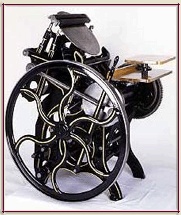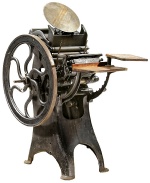
|
Letterpress Printing
in the cold
~~~~~~~~~~ |

|
About temperature in the print
shop. Indeed. The demands of that magic chemistry between ink, rollers,
type and paper
are more respected than any concerns about the physical comfort of any
printer. Many private press shops do not have full climate control and
it can get cold in the print shop - sometimes very cold. So cold that
ink gets very, very stiff - too stiff to work on the press. But, when
it does, we have a solution.
We call it "the ink candle".
When I was
young - about 1965 - I met Mr. Liberty, who was in his late 80's at the
time and had immigrated from Romania. He told me that as a young
printer in
Romania, they had placed a thick candle behind the ink table to keep it
warm so that the ink would spread properly. I laughed to myself as he
told me the story, assuming it was of historical value only.
But,
within a few years, I had my first large press set up in my parents'
unfinished basement and had to apply that trick myself. Of course, you
must be sure to never leave the press idle once the ink candle is lit,
as it will create a hot spot on the ink table. And, if you leave the
ink rollers - especially soft composition rollers on a hot spot like
this - like a certain young printer I know quite well once did -
you will be sadly surprised to return to find a melted roller on your
ink table... So. Use the ink candle if you must - but be forewarned...
A few years ago, we had a visitor to the shop who described a press he
had just looked at. He was cleaning it and was intrigued when he
discovered melted wax on the shelf behind the ink table. He could not
understand why it was there or how it got there. I just laughed
and pointed to the back of my circa 1914 10x15 C&P to show him the
melted wax behind my ink table...
Then I told him the story of Mr. Liberty and his "ink candle" and the
mystery was explained..
The technique works well. In fact, the updated procedure for me on
those very cold winter days in the barn these days
is to remove the entire ink table from the top of the press and lay it
on top of my 'trash can' propane heater to warm it up to 100 degrees or
so, then replace it on the press and light my 'ink candle'. As the ink
table rotates, the candle beneath keeps it work. This technique works
very well.
Of course, summertime brings an equally challenging condition. When it
gets hot and humid, the ink gets very 'soupy' and must be stiffened
with binders to make it usable. Moisture in the paper has an impact as
well, too much moisture and the ink simply will not transfer, but a
little moisture just makes for a stronger impression.
And, when printing large images, it sometimes helps to moisten the back
of the sheets just prior to printing. This is how Gutenberg, Franklin
and all those other horizontal platen press printers were able to
successfully print large forms of type with a flat platen press. A
flatbed cylinder, like the Vandercook, however, has a contact area of
only 18 points as the platen rolls over the bed, and such extreme
measures are rarely, if ever necessary.
Another interesting anecdote about climate control in a printing shop
goes back to the early part of the last century. Mr. Carrier was
contacted to control the temperature and humidity in a New York print
shop so that the heat and moisture would not affect the printing during
a hot summer. His system - the *first* commercial a/c system - worked
well and his "air conditioning" business flourished as a result of the
interest other
printers had for the same system. Eventually Carrier Air Conditioners
became a common household word as we began using his home-sized units
in our windows during the early 60's....
~~~~~~~~~~~~~~~~~~~~~~~~~~~~~~~~~~~~~~~~~~~~
Please contact Alan
Runfeldt
with other questions using this convenient and spam-free
contact
form
page last updated
February 8 July 30, 2007
|